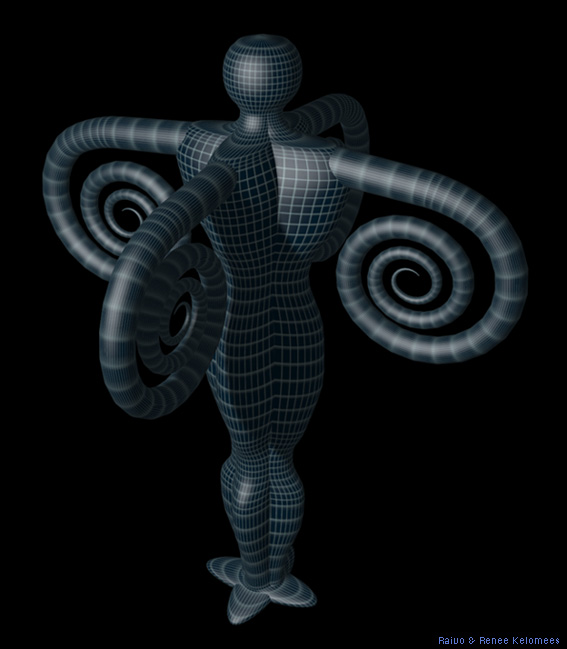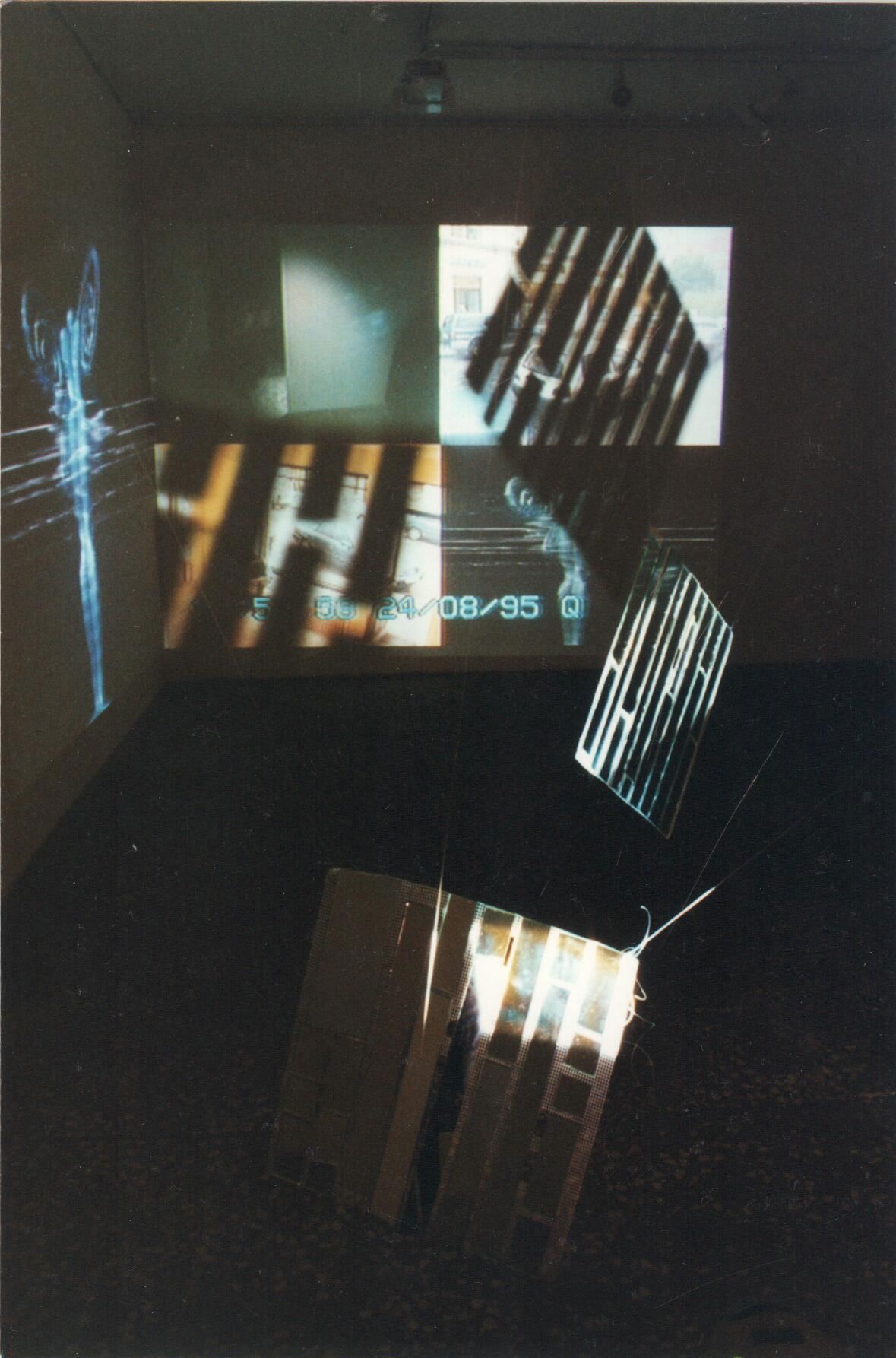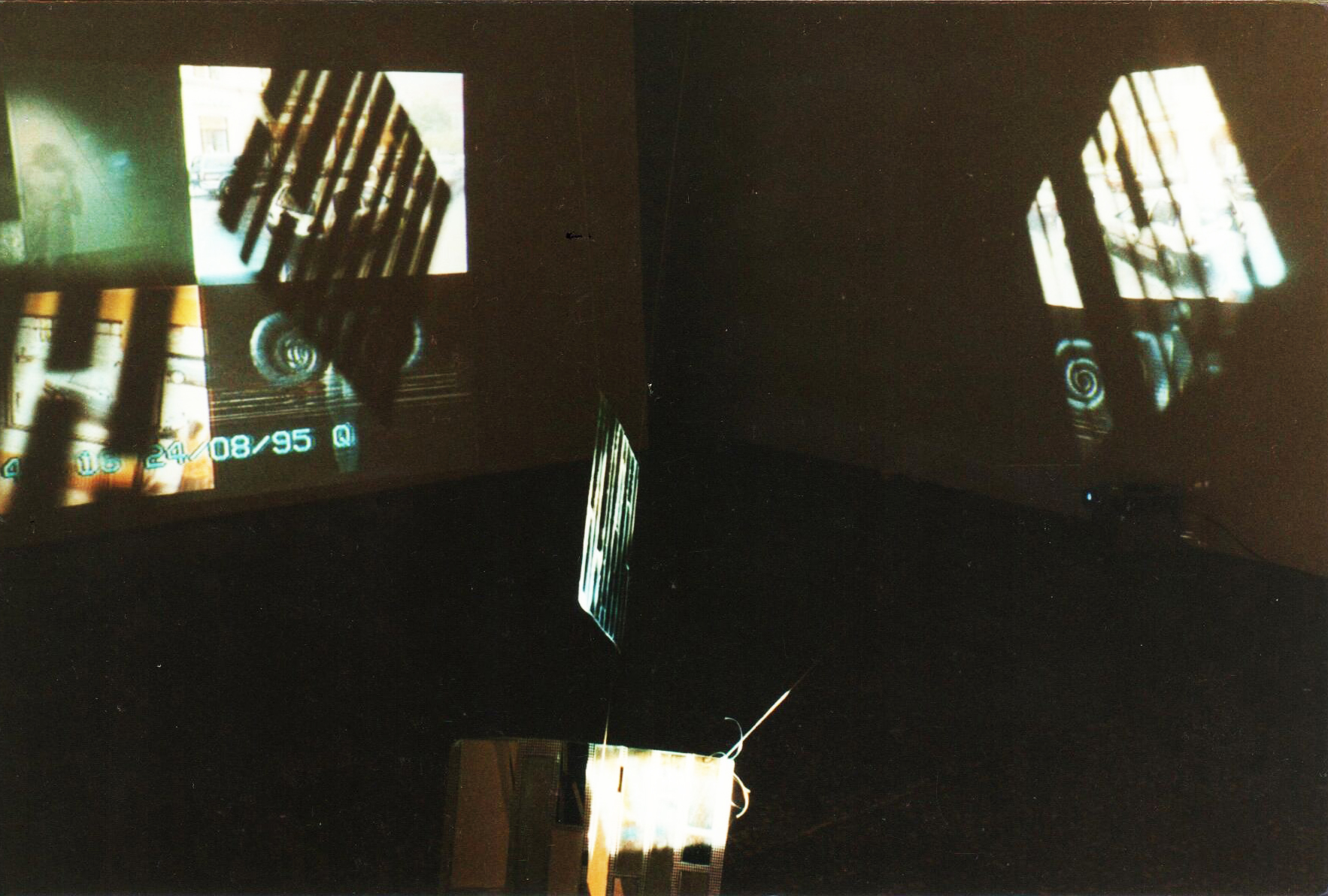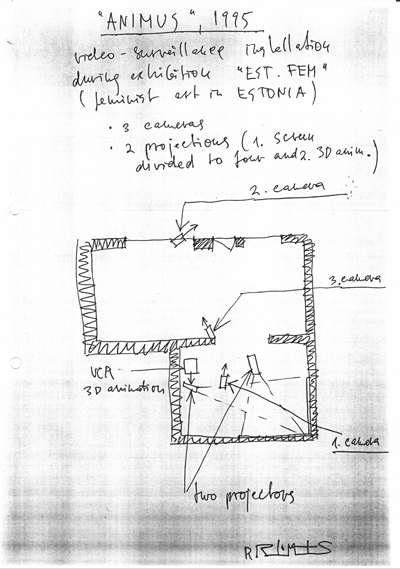|
'Animus' is the sequel or the second part of the project 'Anima' that was performed at 'Dionysia' festival in Tartu. 'Animus' was presented in Tallinn City Gallery (18.8. - 2.9.1995).
Animus
'Animus' is the sequel or the second part of the project 'Anima' that was performed at 'Dionysia' festival in Tartu. The two projects form a whole and designate thus the fulfilment of the author's dreams. I would like to develop the questions of the so-called Estonian feminism further into a more fluid subject, that could be called the fluidity of identity. In this connection, I'd like to refer to my correspondingly titled article in "Vikerkaar" 4/1995, where the subject of observation is not so much the changeability of gender and role identity as the unstableness of mental identity.

What significance holds 'feminism in Estonian art' for a male artist, if this phenomenon doesn't seem to be recognizable even in the form of social movement? Is feminism simply the art of (certain) women, or is it a more comprehensive phenomenon, which could be formulated as the derminateness of art by the sex of the artist?
 |
 |
The latter possibility can be considered in terms of the roles that both sexes are accustomed to or are forced into following in the society that is being observed. However, does the subject of art, its essence and the core of its message depend on the gender of the artist? And is there a specifically feminine aesthetics?
Let's see, what does the video artist and critic Martha Gever have to say on this in her essay "The Feminism Factor: Video and its Relation to Feminism".
There are two polemical essays, published in the 1970's, that have had essential influence on the interrelation of video art and feminism. These are Linda Nochin's "Why Are There No Great Women Artists" and Silvia Bovenschen's "Is There a Feminine Aesthetic?"
The first asserts that the genius of an artist is often associated with masculinity, that this has become a convention. But the signification of success from the standpoint of an individual and from that of an artist is different. The genius-treatments take it often for granted that geniality is connected to success.

Bovenschen is investigating the hypothetical idea of women possessing a specific "feminine sensibility". She concludes that it is not possible to trace a particularly feminine art, criteria for that are not to be found. To the question if there exists feminine aesthetics, she answers that apparently yes if it is the "aesthetic consciousness" and "the ways of sensation" that one is referring to. But not in the sense that there is a specific form of unusual art or some special art theories.
Women-made videos are concerned with the following themes: female sexuality, woman's workload and tasks as a wife, the cult of beauty, house-work policy. The videos of the 1980's deal with the myth of women's passivity and masochism. (Illuminating Video: An Essential Guide to Video Art (ed. Doug Hall and Sally Jo Fifer, Aperture in Association with the Bay Area Video Coalition, 1992).)
Hence, even the most radical representatives of this phenomenon have reached the conclusion "no". But perhaps are the roles performed by individuals in the society and family determined by their gender, in which case it could be conditioning their attitudes towards different phenomena that, in its turn, could be influencing their art as well as anything else they do.
It is not clear yet, whether Estonia has surpassed the accusative level which is concerned with questions like whose life is easier and whose harder, who is discrimiated and who not. One could even maintain, that it is easier for women, for they have whom to accuse and, thus, set their mind at ease. It is easy to claim, that the "masculine discourse of culture" is restrictive and oppressing, or to complain a la if-I-had-not-had-a-child-and-taken-care-of-him-I-could-have-realized-myself... Is the suffering of humans caused by their belonging either to one or another sex or is it simply because this is what the human existence is like - dissatisfying and untolerable?
As for giving birth, this is (as we know) a universal metaphor of creation and... totally unattainable for men. Perhaps would men as well like to take part in this genuine and primeval act of creation which supplements the world with something real. Perhaps this is why male artists are more outstanding numerous - they suffer from the constant lack of experiencing genuine creation, which they are ever left to yearn for. They are incomplete, and therefore jealous.
One could also say that woman creates man, just like man creates woman (metaphorically, of course). So, there are not only real men and women of flesh and blood, but also the imaginary men and women, the images and imprints inside ourselves, which we may not always be aware of.

In the case of these two projects, it is not of importance "to be a man" or "to be a woman", they don't represent either sex. They are composed of impressions, of the imprints of men in women and of women in men. A video imprint of it all, coming to presentation probably later, will be the conclusion of these works. Both projects are observation and video-surveillance installations, so to say. If there is any goal and aim behind all this, it would rather be the erasure of a certain confrontation and the relativization of the whole problem. Everyone, either "a man" or "a woman", is engaged in fighting for his right of self-expression and it seems that it is easy for nobody, least of all for those who are different. Everybody is beating his head against the wall, everyone in his own way. Hence, it is the struggle of an individual for his freedom of self-expression, for the realization of his ideas and for warranting the understanding of the others.
It is essential, that the spectator could take part in it and leave his traces, that he could "get in". This has been his desire and wish. The spectator and the artist, man and woman - who creates whom, who designs whom? The spectator gives birth to the work of art, the artist furnishes him with the means for it.
Extract of the conception
'Animus' in Jungian terminology denotes the "image" or "reflection" of the male in woman. It is the continuous and unmistakable presence of the unexistent, the missing half that is accompanying woman's existence.
It is as if the remainder of psychological and physical uncompleteness and the yearning for unification.
On no account is 'Animus' the desirable or imaginary man with whom the woman would like physically to unite, etc. Nor is it the impression of her father or any other of her relatives.
In brief: it is not an imprint of any real man, but the woman's innate reflection of the male principle, not something that the woman has acquired during her lifetime.
Even though the title signifies the male principle, the subject here is woman. This is a male artist's treatment of the male principle in woman through the contemporary means of expression.
Raivo Kelomees
Translated by Liina Viires
(Text from catalogue: Est.Fem, Ed. by M. Tralla, Tallinn 1995.)
"Animus" 3D design by Renee Kelomees
|